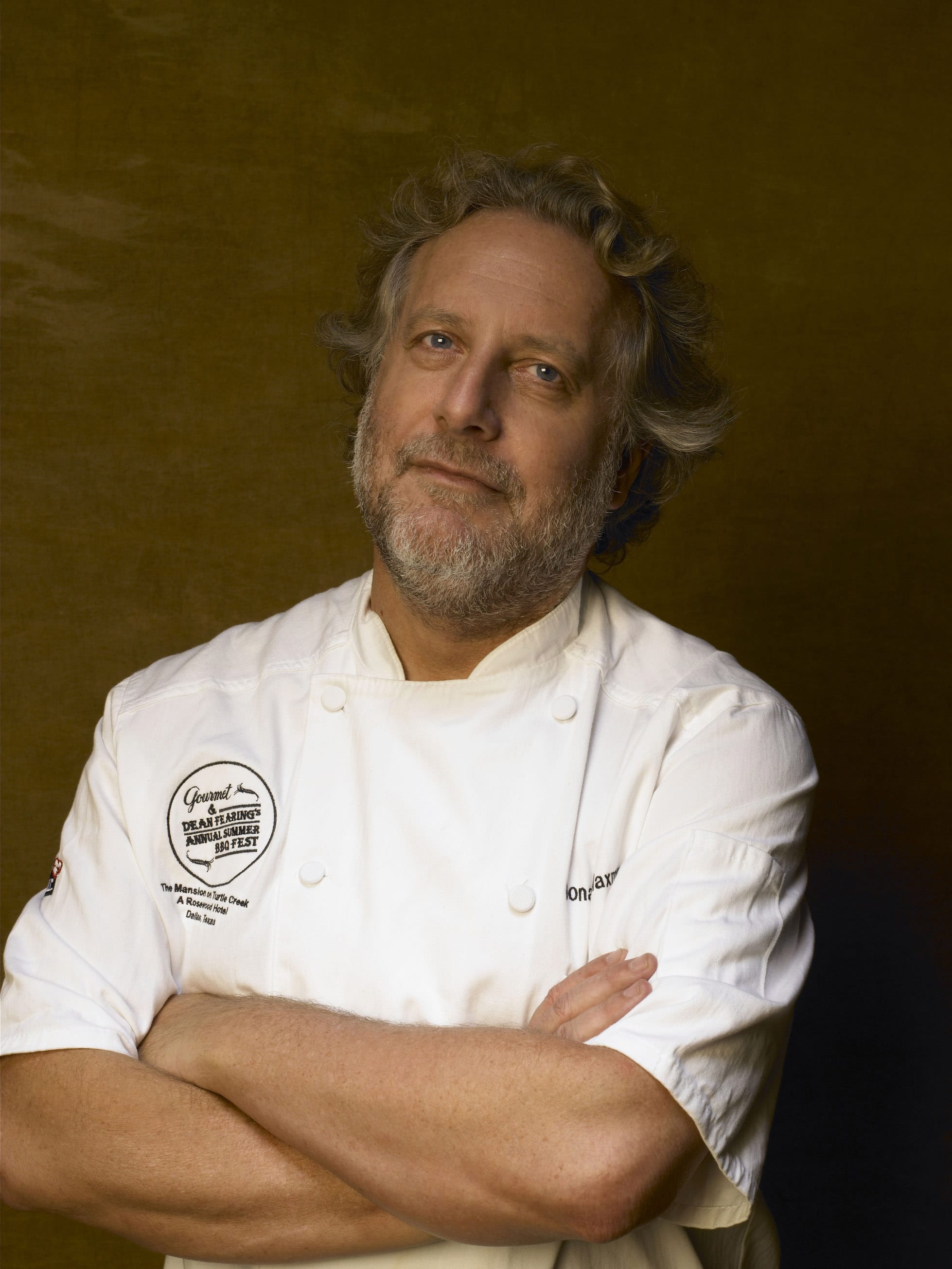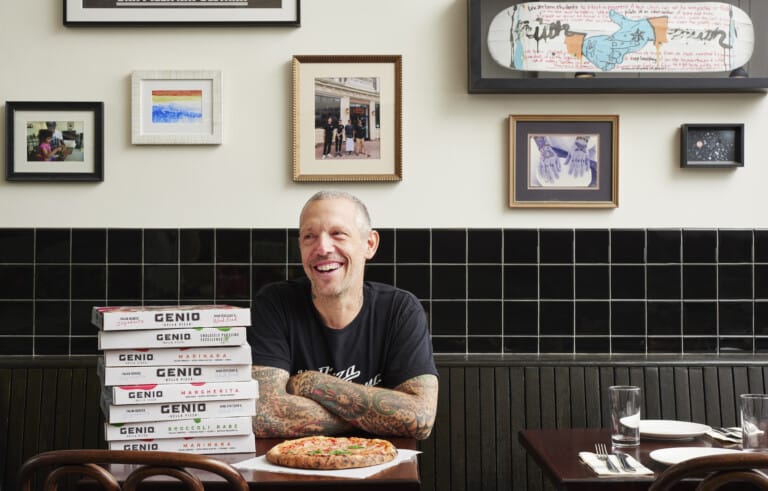Jonathan Waxman, a one-time professional trombonist and so-called Jedi Master from Season 2 of Top Chef Masters, worked in some of California’s most hallowed kitchens, including Chez Panisse in Berkeley and Michael’s in Santa Monica, before he moved to New York and carved out his own culinary niche. He owned a restaurant called Washington Park exactly where you’d expect to be, and is now chef-owner of Barbuto in Tribeca. His Eclectic Cuts recently appeared on Rosa Mexicano menus, spotlighting oft-neglected meats like pork cheek, veal sweetbreads, and lamb neck. I spoke with Waxman by phone on March 1, and he shared more culinary insights.
Was it a given that you’d become a chef, or did you consider other careers?
It’s very strange. I was a musician for many years, I played trombone and went to the University of Nevada at Reno, and part of my job – since I was on scholarship – was to play in the Jazz Lab Band, and the other part of my job was to take as many drugs as possible. Somebody told me, “You just talk about food all the time, you never talk about music, why don’t you just become a chef.” That was 1969. I tucked that away and didn’t really think about it. Years later, I was playing trombone in Hawaii and got stuck in Maui. My friends said, “You can do two things. You could sell drugs or work in a restaurant.” I worked in a restaurant, and didn’t do much per se except fillet frozen mahi mahi.
I came back to Berkley and was selling Ferraris of all things and the owner’s wife told me, “You talk about food all the time. You should be a chef.” It wasn’t until I went to take cooking classes with Mary Risley at Tante Marie that I decided to become a chef. She pushed me…She was very strict but funny about things. About this time, I also took a class from a guy named Richard Grausman, who you know from CCAP. Mary also said, “You should become a chef. You should go to cooking school in London or La Varenne in Paris.” Unbeknownst to me, she signed me for La Varenne. I went to Paris on my birthday, November 16, 1976, not speaking one word of French. It was the greatest move of my life. In Paris, there were all these chefs become celebrities, including Paul Bocuse and Michel Guerard. It was two journalists, Chris Millau and Henri Gault, who were really the ones who created this nouvelle cuisine mystique, who understood food and knew these chefs were doing something different. Their guide is still published in France, Gault Millau. They published a guide to France in English called the Julliard Guide, in ’74 or ’75, and it was all about how these chefs reinvented the wheel, and it was irreverent and funny. Going to Troisgros was an epiphany to me, and I remember what I ate to this day, and what I ate. It was a min- blowing experience to me.
What was your very first night like in a professional restaurant kitchen, and where was that at?
My first night in a professional kitchen, when I graduated from La Varenne, the director Gregory Usher was friends with the people who ran Relais & Châteaux, Ruscoff in Brittany, or this place in the Vosges. I wasn’t accepted at Ruscoff, so I went to Vosges. I arrived, the train station looked out of the Old West, where people brought their pigs and cows on to. Once a day this train stopped at the station, this guy met me and led to [a building], and I believe the pigs slept there too. At the restaurant, it was the chef, a dishwasher and me, in this kitchen. I worked 8 a.m. to 1 a.m. every day, no days off, I got an hour and half break in the afternoon and did a little bit of everything, made stocks, mayonnaise, puff pastry, and went fishing for live trout out of the pond in the middle of service. It was hysterical and amazing.
Who was the chef?
A journeyman chef. He wasn’t anybody famous. When I was in France during that period, chefs were becoming proprietary. It was really rare for chefs to own their own restaurants. Typically, they were owned by businessmen or maitre ‘ds. He was a wonderful man, he was patient with me and I was terrible. I didn’t understand the French system. Here’s the greatest thing, I got paid and I had a working permit…Then my mother got sick that summer, and my father said, “I really need you to come home.”…I was sick of working 18 hours a day, and the food wasn’t that great, so I was ready.
There’s a guy named Hank Rubin, the wine journalist at Food & Wine. He said, “There’s this restaurant opening in Napa named Domain Chandon,” so I went and interviewed. I worked for Udo Nechutnys and Philippe Jeanty. I went to work at Domaine Chandon in 1977 and it’s there where I really learned how to cook. Philippe was amazing. He was this 18-year-old kid with amazing knife skills. I was his English mentor and he was my culinary mentor.
After that I got a job as a head chef at the Monterey Bistro, which is no longer there. While I was there, I got a call from Chez Panisse, where I had previously applied. In those days, you had to audition. I tried to recreate the meal I had at Troisgros, and it was terrible. Years later, Alice told me it wasn’t hard to hire me because she liked my handwriting. That was obviously a pivotal point there, working there. Jeremiah [Towner] had left a year before, but in the kitchen was Mark Miller. Judy Rodgers cooked lunch. Deborah Madison was a prep cook. Jean-Pierre Moullé, who is still there, 35 years later, is one of the best cooks I’ve known in my life. Alice’s technique was her own, and I was always amazed by her skill in the kitchen. Jean Pierre had classic, by the book technique. The two of them together formed this amazing amalgam of what Chef Panisse became. It was beyond mind boggling.
Then I stupidly went to apply for anotehr head chef’s job, I went to Michael’s in Los Angeles. I was hired to be the chef de cuisine for Ken Frank, and after two months, we switched. He wanted to open his own restaurant and didn’t want to work that hard, and I was up for it. Nancy Silverton was an assistant pastry chef, Roy Yamaguchi and Mark Peel were two of my sous chefs. Kazuto Matsusaka was one of my sous chefs.
What do you look for when you’re hiring someone to work in one of your kitchen?
Every summer we ramp up, hire three more people to augment ourselves. We look for people who are passionate, Number 1, Number 2, that they have good communication skills, 3, that they have good hands, 4, that they get a long with other people and can be collaborative, and lastly, that they have the ability to laugh.
Do you see signature dishes as a positive?
It’s funny about signature dishes. Many years ago, at Michael’s, my first signature dish was a wild mushroom salad, a riff on the old wilted spinach salad. I loved when I did it and people love it and after awhile, I thought, “Do I have to do this a millionth time?” I harken back to musicians, who have to play the same songs every year, but it keeps them playing every year, so it’s a two edged sword.
If you work a guest shift at any restaurant for one night, where would you go?
That is a really fantastic question. I wouldn’t mind seeing Noma, but I kind of like the idea of Heston Blumenthal, because I think it would be a lot of fun. Probably Arzak in San Sebastian. That would be a fun place to go. There’s this restaurant that I would love to go work in, La Camelia outside of San Tropez, in France, it’s a big square room, they have grates and cook over an over fire, even bouillabaisse.
Is there anything you don’t enjoy eating?
I did this pork dish for SoBe festival. Somebody asked if I wanted to eat one of the eyes. I didn’t. Things that are too bitter, I’m not that happy with. Things that have a gooey texture. Some Chinese dishes that have gooey texture, which I have an aversion to, but other than, I’m pretty open.
Did you play any sports in high school?
I was supposed to play golf, but what I really wanted to do was smoke pot, so I got seventh period off.
How did the opportunity with Eclectic Cuts come about, and what was your approach with the menu?
I had a conversation with Howard Greenstone, the CEO of Rosa Mexicano, he said, “Would you mind doing consulting work for Rosa Mexicano? Your sensibilities aren’t exactly mine.” I grew up in California, and Mexican food is my go-to food. What I loved about this idea, in Mexico, they eat the innards and all the crazy stuff. What I’m fascinated by is trying to get people weaned off prime cuts. Everybody wants a rib-eye or filet. In California we used tri-tip, a staple in Mexican restaurants. Sweetbreads are something I weaned on in France, and they went out of favor. Different things, like pork cheeks, which I think is the most delicious meat at all. Utilizing different parts of the animal. Fergus Henderson. I love his idea of nose to tail to cuisine. You don’t ignore any part of the animal. You utilize it and celebrate it.
Can you imagine opening a restaurant in Los Angeles at some point?
I think about it all the time. My wife is not happy about thinking it all the time. I met her in L.A., so at some point I wouldn’t mind it. L.A.’s a great food city. All over the world, people appreciate food so much more they did than when I first started out.









Leave a Comment